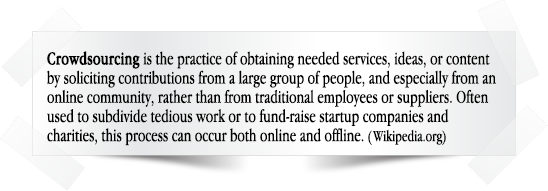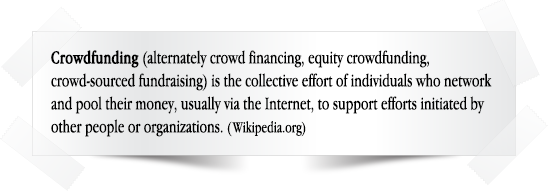 Many creative people, writers included, struggle with the idea of marketing their own work. Our discomfort with this commercial arena—perhaps due to negative impressions created by the hype of horrible advertising campaigns, or our personal fears about being in front of real customers—often leads us to outsource (or abandon altogether) a part of the creative process we can ill afford to miss, namely, finding authentic ways to make direct and meaningful connections with our audience.
Many creative people, writers included, struggle with the idea of marketing their own work. Our discomfort with this commercial arena—perhaps due to negative impressions created by the hype of horrible advertising campaigns, or our personal fears about being in front of real customers—often leads us to outsource (or abandon altogether) a part of the creative process we can ill afford to miss, namely, finding authentic ways to make direct and meaningful connections with our audience.
 Back in the day (say in an 18th-century village context), marketing was simply about sharing the real value of whatever you produced with others in your community. This direct contact with the people who were going to buy your wares not only gave you a market, but also made you a better artisan because your work needed to be good enough to sell itself. Sharing the story of creative endeavors in honest settings such as these are the organic beginnings of today’s marketing practice. Fast forward to the 21st century, and we find ourselves in a very similar village—this time it’s global. We have direct access to a marketing conversation with our readers thanks to the Internet. It’s also become essential that we make these organic connections because even large publishers require their authors to form communities around their work and connect with them.
Back in the day (say in an 18th-century village context), marketing was simply about sharing the real value of whatever you produced with others in your community. This direct contact with the people who were going to buy your wares not only gave you a market, but also made you a better artisan because your work needed to be good enough to sell itself. Sharing the story of creative endeavors in honest settings such as these are the organic beginnings of today’s marketing practice. Fast forward to the 21st century, and we find ourselves in a very similar village—this time it’s global. We have direct access to a marketing conversation with our readers thanks to the Internet. It’s also become essential that we make these organic connections because even large publishers require their authors to form communities around their work and connect with them.
 In marketing my own self-published books, I’ve found a number of helpful (and some not so helpful) channels to get the word out which I’ll share in this article. Needing to take responsibility for communicating what I’ve written, including the need to figure out why anyone else would care, has created useful feedback loops for my creative development as a writer, improving the quality of each successive project and, therefore, its sales appeal. This has been especially true in the pursuit of my inner circles, where some of the more “grass roots” approaches to marketing have given me a direct connection with my audience and an inside look as to how my work is coming across. As I’ve then looked more widely to my outer circles, I’ve been able to learn new things from the process of selling online and connecting with others via social networking. And finally, by following through on the “weak links” I’m naturally connected to, I’ve opened up distribution possibilities that I did not know existed.
In marketing my own self-published books, I’ve found a number of helpful (and some not so helpful) channels to get the word out which I’ll share in this article. Needing to take responsibility for communicating what I’ve written, including the need to figure out why anyone else would care, has created useful feedback loops for my creative development as a writer, improving the quality of each successive project and, therefore, its sales appeal. This has been especially true in the pursuit of my inner circles, where some of the more “grass roots” approaches to marketing have given me a direct connection with my audience and an inside look as to how my work is coming across. As I’ve then looked more widely to my outer circles, I’ve been able to learn new things from the process of selling online and connecting with others via social networking. And finally, by following through on the “weak links” I’m naturally connected to, I’ve opened up distribution possibilities that I did not know existed.

Your Inner Circles
My first suggestion for effectively marketing your book is to start with your closest connections. If marketing is at its roots simply a matter of sharing what you’ve done with people who care, then it makes sense to start with those who you know already care about your subject matter. It could be your network of extended family and friends, or your local book club or writer’s group. Take a couple of copies to your local library or bookstore. Many of our stories begin in our own locale, so it’s natural to share them with the people right around
us.
 Another inner circle approach is to carry your book with you as you move through your life, finding those places along the way where it may have a natural home. As I went to my various public speaking gigs, I would take my books along (or have them drop-shipped to meet me) and sell them to students or attendees. You can do the same thing as you attend functions that relate to your theme, or create public reading opportunities at conferences and workshops. Perhaps you already attend inner circle gatherings centered around your genre, like Comic-Con if you’re a graphic novelist, or the local AA chapter if you’ve written your own self-help title. As you connect authentically with these natural audiences you’ll find your work markets itself.
Another inner circle approach is to carry your book with you as you move through your life, finding those places along the way where it may have a natural home. As I went to my various public speaking gigs, I would take my books along (or have them drop-shipped to meet me) and sell them to students or attendees. You can do the same thing as you attend functions that relate to your theme, or create public reading opportunities at conferences and workshops. Perhaps you already attend inner circle gatherings centered around your genre, like Comic-Con if you’re a graphic novelist, or the local AA chapter if you’ve written your own self-help title. As you connect authentically with these natural audiences you’ll find your work markets itself.
Sometimes our inner circle isn’t around the corner, it’s online. When I wrote my first book, I started a blog that focused on various chapters as discussion points. Once the book came out, the people already in my blogging community continued to build on the themes via their own posts. Here’s what it developed into: http://patrickdodson.tumblr.com. Here’s another example, the blog I created for my third book: http://patrickdodsonidentity.tumblr.com
 A blog can also be extended over time to become a full website for you as an author. You can use this format to do any number of things that typically blogs don’t focus on, such as giving longer summaries of your work, making free chapters available, or sharing a video of yourself doing a reading or a radio interview. A personal website is also a good place to publicize information on where you’ll be speaking about your book or doing a public reading. You could also consider allowing people to buy the book directly from your site. Here’s a good web example from my friend Mark Scandrette: http://markscandrette.com
A blog can also be extended over time to become a full website for you as an author. You can use this format to do any number of things that typically blogs don’t focus on, such as giving longer summaries of your work, making free chapters available, or sharing a video of yourself doing a reading or a radio interview. A personal website is also a good place to publicize information on where you’ll be speaking about your book or doing a public reading. You could also consider allowing people to buy the book directly from your site. Here’s a good web example from my friend Mark Scandrette: http://markscandrette.com

Your Outer Circles
People who don’t know you at all (yet) are your outer circles. When you first publish your book, you will be automatically presented with a few opportunities to connect with the world and make an initial impression. Most people who come across your book online or in a bookstore will want to know who you are and what you’re talking about. This starts with a well-worded blurb on the back of your book. This same blurb will go digital when your book is listed online, ending up in people’s Google search results. Along with the blurb, make sure that your Amazon book description, author’s page, and relevant reviews are accurate and positive.
“Pre-sales” information like this goes a long way towards informing a potential buyer’s decision making.
 Another way to connect with people online who haven’t met you yet is to use the “Look Inside” feature Amazon provides. This feature allows people to read a free chapter (or more) to help them decide if the book is something they really want. Hopefully, some of the people who buy your book will go on to write reviews for you on that same Amazon page. Reviews create an intermediary effect between your work and the market by providing an objective impression of your book. In the same way, bloggers may write about your work, or a magazine may do a piece talking you up. One of the best intermediaries is an independent book reviewer like Publishers Weekly, who is considered a
Another way to connect with people online who haven’t met you yet is to use the “Look Inside” feature Amazon provides. This feature allows people to read a free chapter (or more) to help them decide if the book is something they really want. Hopefully, some of the people who buy your book will go on to write reviews for you on that same Amazon page. Reviews create an intermediary effect between your work and the market by providing an objective impression of your book. In the same way, bloggers may write about your work, or a magazine may do a piece talking you up. One of the best intermediaries is an independent book reviewer like Publishers Weekly, who is considered a
trusted review source and a great place to start. You can find their guidelines here:
www.publishersweekly.com/pw/corp/submissionguidelines.html

Weak Links
Once you’ve done the rounds of your inner circles, and you’ve done your best to connect to your outer circles, it’s time to look at the serendipity of your weak links. Weak links are potential connections to relationships not yet fully realized. Weak links center on the idea of six degrees of separation to connect the rest of the world with your project. For example, you talk to a friend who has a friend who works at a magazine you think your work might connect with, and so you politely ask for their details and the permission to follow them up.
Sending a book off to a weak connection is like throwing seeds out into the field—you have no idea if any of them are going to take, but if they do, they tend to multiply like crazy. I’ve sent a number of my books off to friends of friends in the hope that they may want to tell others. I’ve got some good distribution opportunities and the odd Webcast interview by doing this.

Back to the Village
The last marketing tool I want to mention harkens back to advertising’s original form—finding ways to make organic, beneficial connections. One of the best examples of this kind of grassroots marketing today is crowdsourcingand crowdfunding.

I used both of these methods with my last book, which not only helped me sell it once it was finished, but also helped me form some of the content along the way. Crowdsourcing expands your personal creative process into a collaborative one while often developing whole new marketing circles in the most natural of ways. There are many online services available like KickStarter.com which get you up and crowdsourcing quickly. But in the spirit of self-publishing, I decided to create my own which you can see here.
 Learning to market my own work to my own communities has been a creative endeavor all on its own. If my initial efforts scale naturally to some larger success—like getting picked up by a traditional publisher at some point—then that’s great. At least I know I’ve worked out as many of the kinks as I could. I would encourage you to do the same. Take self-publishing as an opportunity to learn the whole creative gamut from writing well to selling well. As you work out the details of the entire process, you’ll be well prepared for any further opportunities and the successes that may follow.
Learning to market my own work to my own communities has been a creative endeavor all on its own. If my initial efforts scale naturally to some larger success—like getting picked up by a traditional publisher at some point—then that’s great. At least I know I’ve worked out as many of the kinks as I could. I would encourage you to do the same. Take self-publishing as an opportunity to learn the whole creative gamut from writing well to selling well. As you work out the details of the entire process, you’ll be well prepared for any further opportunities and the successes that may follow.
All the best to you and your work,
Patrick
About the author:
Patrick Dodson is an international public speaker covering topics ranging from personal development to shifting cultural trends. Over the last four years, borrowing from his professional experience, he’s published three books: Stuff my Father Never Told Me About Relationships in 2009, Psychotic Inertia in 2010, and The Identity Project in 2011. These books are available worldwide both in print and ebook formats. He’s currently living in a cabin by a remote lake working on two new books, his second screenplay, and eating like a king (one of the books is a cookbook). Visit his website at http://www.patrickdodson.net
Also by Patrick Dodson:
Part 1: The Craft of Writing for Self-Publishing
Part 2: The Craft of Editing for Self-Publishing
Part 3: How to Print and Distribute Your Self-Published Book



